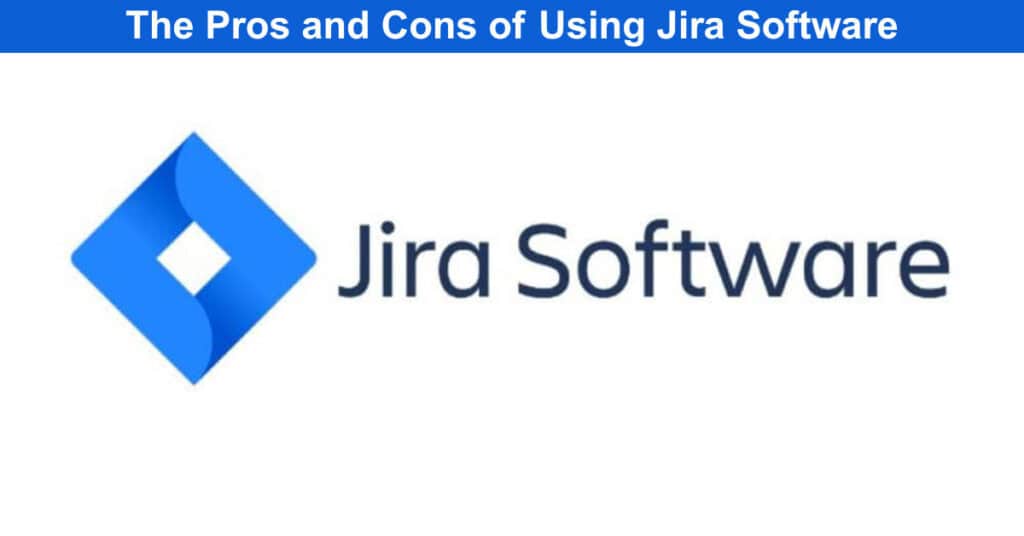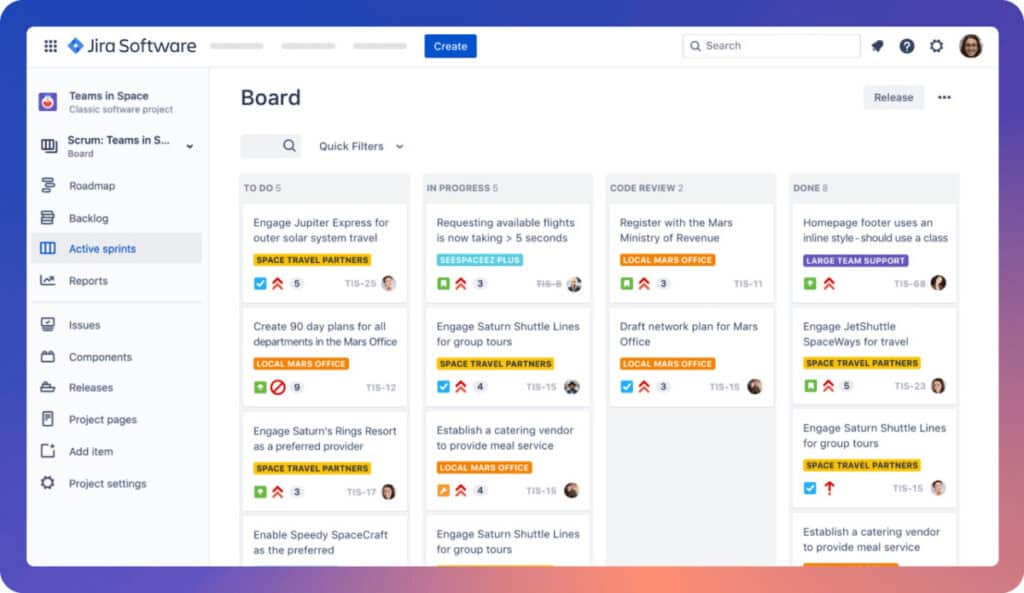
Managing workflows, tasks, and communication challenges can quickly become daunting for teams and business operations that are growing. One way to alleviate these growing pains is by adopting agile management practices, which promote flexibility, collaboration, and continuous improvement. A key aspect of this approach is streamlining your processes and selecting the right tools to support your team’s agile needs.
There are many agile management solutions, but Jira Software is one of the best tools designed for agile teams of all sizes. This article will explore the pros and cons of using Jira Software, its features, and use cases so you can better understand how it can support your team at every step of your growth journey.
If you find that Jira’s pricing system exceeds your budget, you might consider AceProject as an alternative. Unlike Jira, AceProject’s pricing is not based on the number of users, which could result in significant savings for you.
Jira – Issue & Project Tracking Software
Jira software, developed by Atlassian, is the top-rated issue and project tracking software agile teams use worldwide, especially when integrated with software testing tools to reduce bugs and improve release confidence. With a focus on moving fast, staying aligned, and building better products, this comprehensive tool offers a single source of truth for all your project management needs. Jira provides ultimate tools that allow you to effectively plan, track, release, report, and automate tasks, ensuring seamless collaboration and efficient execution across the board. As the preferred choice for software development teams, Jira Software has become synonymous with agile methodology and streamlined project management.

One of Jira’s standout features is its array of ready-made templates, which give you a head start by providing tailored solutions for different project types and industries. These templates can be easily customized as your team grows and evolves, allowing Jira to adapt to your unique working style instead of the other way around. You can easily integrate various third-party tools through the Atlassian Marketplace, including software documentation tools that help teams maintain clear and accurate technical knowledge as projects scale. This makes Jira the central hub for your team’s project management needs.
This flexible and adaptable approach has solidified Jira’s position as the go-to software for agile teams looking to enhance their productivity and collaboration. When it comes to project management solutions, Monday.com compares to Jira, with each offering distinct advantages—Jira excels in software development environments, while Monday.com’s versatility makes it well-suited for diverse team requirements across various industries.
Jira Key Features
Jira Software’s key features cater to a wide range of project management and team collaboration needs:
- Scrum and Kanban: Utilize powerful, agile boards to manage tasks and monitor progress, catering to both Scrum and Kanban methodologies.
- Roadmaps: Plan and align your team’s work with clear visual roadmaps, ensuring everyone stays focused and on track.
- Reports and Insights: Gain valuable insights from detailed reports to learn and continuously improve your team’s performance.
- Project Autonomy and Structure: Maintain project control with customizable settings and granular permissions.
- Customizable Workflows: Tailor your workflows to suit your team’s specific needs, ensuring maximum efficiency.
- Extend With Apps and Integrations: The Atlassian Marketplace offers a wide range of third-party apps and integrations that can enhance Jira’s capabilities.
- Drag and Drop Automation: Simplify and streamline processes with intuitive drag-and-drop automation features.
- Open DevOps: Foster cross-functional collaboration and embrace a DevOps culture with Jira’s open platform.
- Designed for security and scale: Rest assured that Jira Software is built with robust security measures and can easily scale as your team and organization grow.
Jira Use Cases
Jira Software has established itself as a versatile and reliable project management solution catering to the needs of startups, small businesses, and large enterprises. With over 100,000 customers worldwide, including industry leaders such as Square, eBay, Visa, Cisco, and Pfizer, Jira is designed to support agile teams in various industries. With its adaptability and robust functionality, it can support teams ranging from just 1 to 20,000 members.
- Software Development Teams: Jira’s Scrum and Kanban boards, along with its customization options, streamline project management for developers.
- IT Operations: Efficiently manage IT infrastructure, track issues, and maintain service quality with Jira’s powerful tracking capabilities.
- Business Services and Operations: Enhance collaboration, communication, and project execution across diverse departments, including finance, procurement, and administration.
- Marketing Strategy Teams: Plan, execute, and monitor marketing campaigns, tracking progress and analyzing results for continuous improvement.
- HR for People Management: Manage onboarding, performance evaluations, and employee relations with Jira’s customizable workflows and integrations.
- Government: Deliver efficient, secure, mission-focused services with Jira’s robust features and compliance options.
- Incident Response: Track, manage, and resolve incidents swiftly, ensuring minimal downtime and business continuity.
The Cons or Disadvantages of Jira
While Jira Software is undoubtedly a powerful and versatile project management tool, it’s essential to consider some of the potential drawbacks that users may encounter. Here are some of them:
- Challenging Setup: Jira’s extensive features and customization options can make initial setup and familiarization a complex process, particularly for those new to project management tools.
- Mainly for Engineering and Software Development: Although adaptable, Jira is primarily geared towards engineering and software development teams, which may limit its effectiveness in other industries or departments.
- No Idea Management Feature: Jira lacks built-in idea management functionality, which may require teams to seek additional brainstorming and concept development tools.
- Costly for Small Teams: Jira’s pricing structure may be prohibitive for small teams or startups with limited budgets.
- Slow Query Load Times: Users have reported slow query load times, which can affect overall performance and efficiency, especially in larger organizations.
- Real-Time Updates Need Improvement: Jira’s real-time update feature could benefit from enhancements, as some users report delays in the display of new information.
- No Built-In Timeline: The absence of a built-in timeline to track project progress may require users to rely on third-party plugins or other tools for visualizing and managing project timelines.
The Pros or Advantages of Jira
Despite some drawbacks that can be improved over time, Jira offers multiple capabilities that organizations worldwide rely on. Here are the key advantages of using Jira Software.
- Agile and Scrum Management: Jira supports agile methodologies like Scrum, providing tailored features such as Scrum boards, sprints, and backlogs.
- Customization: Jira’s highly customizable functions allow teams to tailor workflows, fields, and issue types to fit their requirements. This includes the use of Jira templates to standardize and streamline recurring project types.
- Work Visualization: With its intuitive board layouts and clear status indicators, Jira enables effective visualization of work items and progress.
- Work-in-Progress Limit: Set limits on work items in specific stages to prevent bottlenecks and maintain a smooth flow of tasks through the system.
- Dynamic Progress Tracking: Jira’s real-time tracking capabilities allow teams to monitor project progress and performance, making data-driven decisions for continuous improvement.
- User-Friendly Tool: With its well-defined structure and easy-to-use interface, Jira facilitates efficient project management for teams of all sizes.
- Seamless Navigation: Jira offers smooth navigation between boards, backlogs, and other views, enabling users to access relevant information quickly.
- Integrations: Jira’s compatibility with many apps and integrations allows teams to extend its functionality and connect with other tools, creating a cohesive project management ecosystem.
Jira Pricing and Costs
Jira Software offers a flexible pricing structure to accommodate teams of various sizes and budgets. The cost is determined based on the number of users on your team and your preferred billing frequency – either monthly or annually. Jira provides a Free plan at $0, which supports up to ten users, making it an accessible option for small teams or startups looking to explore the platform’s capabilities. As your team grows and requires additional features, you can seamlessly transition to higher-tier plans tailored to your evolving needs. We did an article on Jira Pricing Plans.
Conclusion
Jira’s adaptability for agile teams, dynamic customization, and robust functionality make it a valuable asset for many teams seeking to streamline their processes, enhance collaboration, and ultimately drive project success. By carefully considering the pros and cons of Jira Software and its features, use cases, and pricing, your organization can quickly decide whether this tool fits your project management needs.
Suggested articles:
- The Pros and Cons of Using Monday.com Software
- The Pros and Cons of Using Asana Software
- The Pros and Cons of Using Wrike Software
Peter Kanai is a Google-certified freelance writer with over a decade of experience crafting high-quality content for business websites, blogs, and SEO & email marketing campaigns. His on-demand writing services are all about helping businesses expand their online presence and achieve their objectives. With a proven track record in delivering results-driven content, Peter is the go-to freelance writer for business owners seeking a strategic partner to help them grow their brand online.